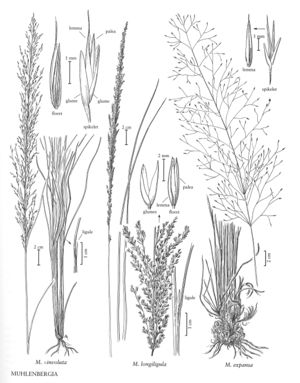Difference between revisions of "Muhlenbergia longiligula"
imported>Volume Importer |
imported>Volume Importer |
||
| Line 39: | Line 39: | ||
|publication year= | |publication year= | ||
|special status= | |special status= | ||
| − | |source xml=https://bitbucket.org/aafc-mbb/fna-data-curation/src/ | + | |source xml=https://bitbucket.org/aafc-mbb/fna-data-curation/src/200273ad09963decb8fc72550212de541d86569d/coarse_grained_fna_xml/V25/V25_766.xml |
|subfamily=Poaceae subfam. Chloridoideae | |subfamily=Poaceae subfam. Chloridoideae | ||
|tribe=Poaceae tribe Cynodonteae | |tribe=Poaceae tribe Cynodonteae | ||
Latest revision as of 17:58, 11 May 2021
Plants perennial; cespitose, not rhizomatous. Culms 60-130 cm, stout, erect; internodes mostly smooth, sometimes scabridulous below the nodes. Sheaths shorter or longer than the internodes, smooth or scabridulous, not becoming spirally coiled, basal sheaths rounded; ligules 10-30 mm, firm and brown basally, membranous distally, acuminate to obtuse; blades (10)20-65 cm long, 3-6 mm wide, flat or inrolled at the margins, scabrous abaxially, scabridulous or smooth adaxially. Panicles 15-55 cm long, 1-15 cm wide, contracted to open, greenish-tan to purplish; primary branches 3-13 cm, narrowly ascending or diverging up to 60° from the rachises, stiff, spikelet-bearing to the base, lower branches with 30-60 spikelets; pedicels 0.1-2.5 mm, usually shorter than the spikelets, scabridulous or smooth, strongly divergent. Spikelets 2-3.5 mm. Glumes subequal, 2-3.5 mm, usually longer than the florets, scabridulous or smooth, 1(2)-veined, acute to acuminate, usually unawned, rarely awned, awns to 0.2 mm; lemmas 2-2.9 mm, oblong-elliptic, tan to purplish, smooth or scabridulous, apices acute, often bifid, teeth to 0.2 mm, unawned or awned, awns to 2 mm; paleas 2-3 mm, oblong-elliptic, scabridulous or smooth, acute; anthers 1-2.1 mm, yellowish to purplish. Caryopses 1.1-1.5 mm, fusiform, reddish-brown. 2n = 22, 24, 29, 30.
Distribution
Ariz., N.Mex., Nev., Tex.
Discussion
Muhlenbergia longiligula grows on rocky slopes, canyons, and rock outcrops derived from volcanic or calcareous parent materials, at elevations of 1220-2500 m. It is a common species in Arizona and southwestern New Mexico, and extends into northwestern Mexico. It may be confused with M. emersleyi, but differs from that species in its rounded basal leaf sheaths, glabrous lemmas, and panicle branches that are spikelet-bearing to the base. It is also similar to M. lindheimeri, but differs in its rounded basal sheaths.
Selected References
None.
